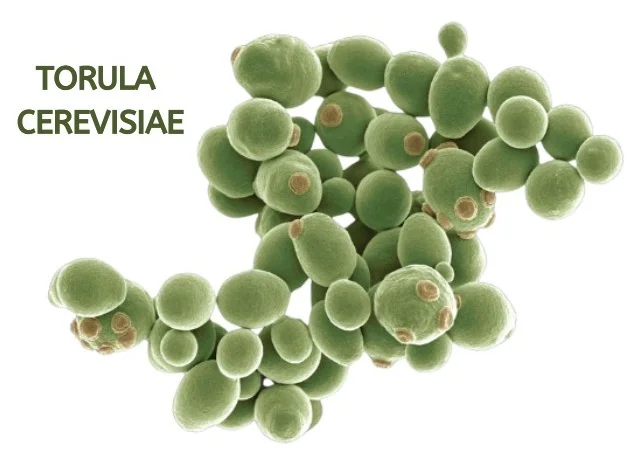Torula Cerevisiae, also known as Saccharomyces or Yeast Plant, is a fungal organism commonly used in brewing, baking, and wine-making due to its fermenting abilities.
In homeopathy, Torula Cerevisiae was introduced by Dr. Lehman and Yingling, primarily for its clinical application in treating conditions related to digestive and respiratory problems.
Although it hasn’t undergone full proving, it has been shown to be effective in many cases, particularly for sycotic conditions (those with overproduction of tissue or discharge) and anaphylactic reactions triggered by proteins and enzymes.

Table of Contents
ToggleSOURCE INFORMATION
Scientific Classification
- Kingdom: Fungi
- Phylum: Ascomycota
- Class: Saccharomycetes
- Order: Saccharomycetales
- Family: Saccharomycetaceae
- Genus: Saccharomyces
- Species: Saccharomyces cerevisiae
Origin and Historical Facts
- Yeast, particularly Saccharomyces cerevisiae, has been used for centuries in baking, brewing, and fermentation.
- Its medicinal use dates back to ancient cultures where yeast poultices were applied to skin infections.
- In homeopathy, Torula Cerevisiae gained recognition due to its effectiveness in treating conditions such as digestive disturbances, skin infections like eczema, and anaphylactic reactions.
DRUG PATHOGENESIS
- Torula Cerevisiae is primarily linked to digestive disturbances, nervous irritability, respiratory discomfort, and skin conditions.
- Its pathogenesis includes the production of sour, yeasty discharges and a moldy odor, reflecting its affinity for digestive fermentation and skin infections.
PHYSICAL CONSTITUTION, DIATHESIS, AND TEMPERAMENTS
- Physical Constitution: Best suited for individuals with digestive issues, recurrent boils, and eczema.
- Diathesis: Individuals prone to sycotic conditions, which involve overproduction of tissue or excessive discharge.
- Temperament: Applicable to those who experience irritability and restlessness due to digestive and respiratory disturbances.
WHAT IS CONSTITUTION IN HOMOEOPATHY?
WHAT IS DIATHESIS IN HOMOEOPATHY?
WHAT ARE TEMPERAMENTS IN HOMOEOPATHY?
KEY CHARACTERISTICS
- Marked digestive symptoms with a sour, yeasty odour to discharges.
- Recurrent boils and skin infections, particularly around the ankles.
- Backache and a feeling of weakness, particularly from the elbows and knees down.
- Cold hands that go numb easily.
- Catarrhal discharge from the nose with sneezing and wheezing.
DETAILED ORGAN SYMPTOMS
HEAD
- Aching pain at the back of the head and neck.
- Sharp, shifting pains all over the head, aggravated by constipation.
- Irritability and nervous tension accompany these symptoms.
STOMACH
- Nausea, poor digestion, and belching of gas from the stomach and abdomen.
- A persistent sense of fullness and soreness across the abdomen, with rumbling and shifting pains.
- The discharges from the digestive system are often sour, yeasty, and have a moldy odor.
RESPIRATORY SYSTEM
- Catarrhal discharge from the posterior nares (back of the nose), accompanied by sneezing and wheezing.
EXTREMITIES
- Tiredness and weakness in the limbs, especially from the elbows and knees down.
- Hands feel icy cold and tend to go numb or fall asleep easily.
- Backache is also a common symptom, especially after physical exertion.
SKIN
- Recurrent boils and eczema, especially around the ankles.
- The skin often itches, and tinea versicolor (a fungal skin infection) may be present.
SLEEP
- Restless sleep, with constant movement and difficulty in achieving restful slumber.
MODALITIES
- Worse: Symptoms are aggravated by constipation and may worsen in cold environments.
- Better: Warm applications and improving digestion can alleviate some of the discomfort.
WHAT ARE MODALITIES IN HOMOEOPATHY?
RELATIONSHIP WITH OTHER DRUGS
Compare with
- Calcarea Sulphurica (for recurrent boils and skin infections).
- Natrum Sulphuricum (for flatulence and digestive complaints).
- Sulphur (for skin conditions and digestive disturbances).
- Thuja (for sycotic tendencies and skin ailments).
DOSE
- Can be taken in pure yeast cake form, or as potencies from the 3rd to higher dilutions, depending on the severity of the symptoms.
- Yeast poultices are also commonly used for treating boils, skin infections, and swelling.
Frequently Asked Questions
What is Torula Cerevisiae used for in homeopathy?
- Torula Cerevisiae is primarily used to treat digestive disturbances, skin infections like recurrent boils and eczema, and respiratory discomfort like sneezing and wheezing.
How does Torula Cerevisiae help with digestive issues?
- It relieves symptoms like nausea, belching, abdominal soreness, and flatulence by addressing the fermentation process and improving overall digestion.
Can Torula Cerevisiae be used for skin conditions?
- Yes, it is especially effective for treating recurrent boils, itching eczema, and fungal infections like tinea versicolor.
What is the recommended dose of Torula Cerevisiae?
- The recommended dose varies from tincture form or lower potencies to high potencies.
- Pure yeast cakes are also used, particularly for external application in the form of poultices for skin conditions.
Glossary of Difficult Words
- Sycotic: Referring to conditions involving overproduction of tissue or excessive discharge.
- Catarrhal: Relating to inflammation of mucous membranes, typically with excessive discharge.
- Tinea versicolor: A fungal skin infection that causes small, discolored patches on the skin.
- Posterior nares: The back part of the nasal cavity.
- Anaphylactic: Referring to a severe allergic reaction.
